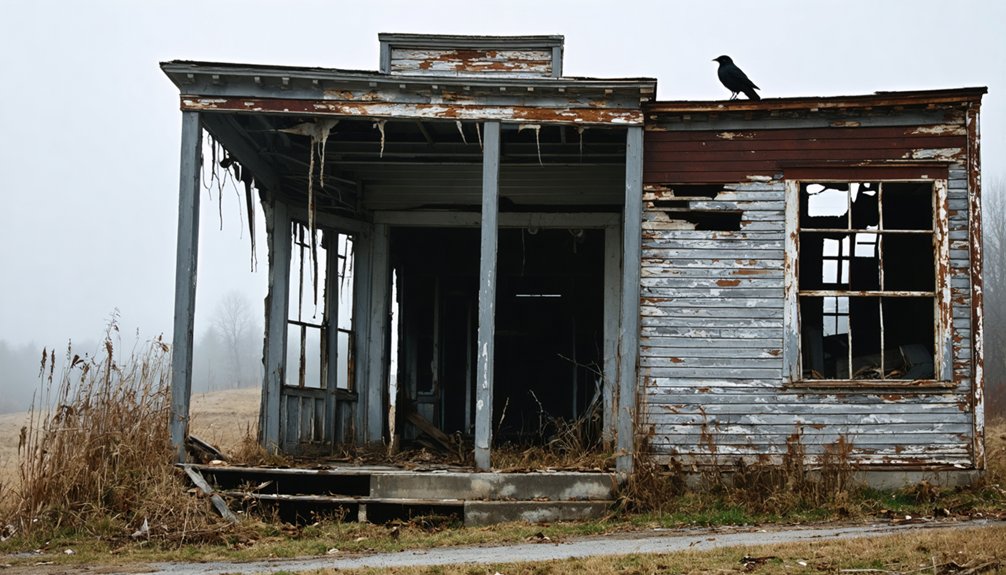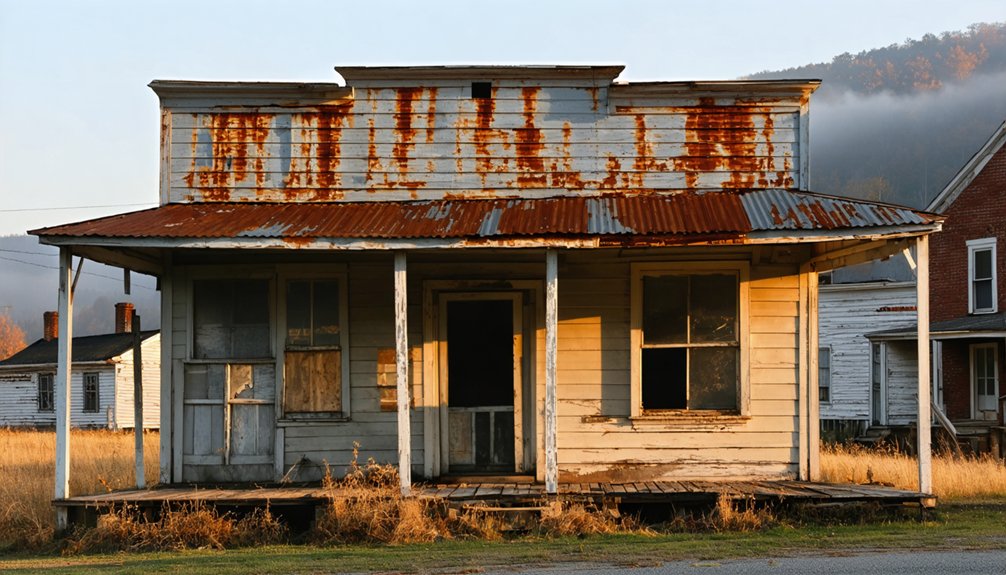You’ll discover Birmingham, Kentucky’s haunting story along the Tennessee River, where a once-thriving port town now rests beneath Kentucky Lake. Founded in 1849, it grew into a bustling community of 900 residents before facing dark chapters of racial violence and eventual displacement. The Tennessee Valley Authority’s Kentucky Dam project in 1944 sealed the town’s fate, leaving roads, foundations, and untold stories waiting in the depths below.
Key Takeaways
- Birmingham, Kentucky was established in 1849 and thrived as a riverside town until its complete submersion under Kentucky Lake in 1944.
- The town peaked at 900 residents in the 1920s before the Tennessee Valley Authority’s Kentucky Dam project forced evacuation.
- Violent racial attacks by Night Riders in 1908 led by Dr. Emilius Champion drastically changed the town’s demographics.
- The town’s remains, including building foundations and roads, now rest beneath Kentucky Lake’s waters.
- Birmingham served as a significant river commerce hub until its flooding, with remnants now attracting underwater archaeologists and historians.
A Thriving River Port Town’s Early Days
While many Kentucky river towns sprouted up during the mid-19th century, Birmingham emerged as a particularly ambitious venture in 1849 when Thomas Love established it along the Tennessee River in Marshall County.
Named after England’s industrial powerhouse, the town aimed to replicate its namesake’s success with early ironworks and manufacturing prowess.
Kentucky’s Birmingham dreamed of matching its English counterpart’s industrial might through local manufacturing and iron production ventures.
You’ll find that Birmingham quickly developed into a bustling river transport hub after its incorporation in 1860.
The town’s strategic location, originally platted on Thomas A. Grubbs’ land in 1853, made it ideal for commerce. This location mirrored other river settlements like Shippingport Borough in Pennsylvania, which also leveraged its waterfront position for growth.
Within decades, the settlement boasted a thriving stave mill employing over 200 workers, multiple businesses, and a ferry service that connected both sides of the Tennessee River, establishing itself as an essential link in Kentucky’s river trade network. By the early twentieth century, the town had grown to include 500 residents, marking its peak population.
The Dark Chapter of Night Riders and Racial Violence
Birmingham’s prosperous river commerce took a sinister turn in 1908 when the Night Riders, a vigilante group originally focused on tobacco farmers’ economic grievances, expanded their terror campaign into the Jackson Purchase region.
Led by Dr. Emilius Champion of Lyon County, nearly 200 masked men crossed the Tennessee River one fateful March night. They’d studied Klan tactics and coordinated with local Marshall County riders to release racial terror on Birmingham’s Black residents. Operating much like the Silent Brigade of the Black Patch War, they used intimidation and violence to achieve their goals.
The raiders brutally beat African Americans and delivered ultimatums from atop stumps: leave town immediately or face deadly consequences. By sunrise, families fled with only what they could carry, seeking refuge in Paducah, Louisville, and Illinois.
You can trace their calculated approach – from muffled horses to synchronized attacks. They strategically cut communication lines to prevent residents from calling for help.
This vigilante violence permanently altered Birmingham’s demographics and marked a dark chapter in Kentucky history.
Life Along the Tennessee River: Community and Commerce
Along the fertile banks of the Tennessee River, life in Birmingham flourished through decades of bustling riverfront commerce and tight-knit community bonds.
You’d find a diverse population, including successful African American farmers who owned prime agricultural land near the waterfront. Much like its British namesake city that became the first manufacturing town in the world, the river served as the town’s lifeline, powering local industries and connecting you to distant markets through regular trade routes.
Community events brought everyone together while the river provided endless recreational opportunities. You could spend your days fishing, boating, or gathering at the bustling docks where merchants traded their goods.
The town’s strategic location, about 8 miles from Benton, made it a natural hub for river commerce. Despite periodic flooding challenges, Birmingham’s residents adapted and built a resilient community that thrived on the river’s resources. In 1944, the completion of Kentucky Dam forced the entire town to relocate as rising waters submerged Birmingham beneath Kentucky Lake.
TVA’s Kentucky Dam and the Town’s Final Days
In 1938, the Tennessee Valley Authority launched an ambitious project that would forever change the landscape of western Kentucky – the construction of Kentucky Dam.
You can trace the town of Birmingham’s final chapter through this massive undertaking, which promised flood control and hydroelectric power for the region.
While the TVA notified Birmingham’s residents to relocate, you won’t find records of an organized community relocation effort.
Before the flooding, Birmingham was a bustling town with over 900 residents by the 1920s.
Instead, the town’s few hundred inhabitants gradually dispersed as the waters began to rise. Unlike other affected communities that moved to higher ground, Birmingham simply faded away.
Located at mile marker 30, Birmingham once served as a vital shipping hub along the Tennessee River.
By 1944, when Kentucky Lake filled, the town’s streets, buildings, and memories slipped beneath the surface.
Today, you’ll find Birmingham’s remnants preserved in the lake’s depths – a silent reminder of the price of progress.
Beneath Kentucky Lake: A Submerged Legacy
Beneath the tranquil waters of Kentucky Lake, you’ll find the remnants of a once-thriving town that served as Marshall County’s commercial hub.
Today, underwater archaeology reveals Birmingham’s fascinating submerged history: old roads, building foundations, and even some untouched cemeteries rest several feet below the surface.
You can trace the physical legacy of this community through artifacts that tell stories of early American life. The Tennessee Valley Authority announced the town’s fate in 1938, leading to a complete relocation of its residents. The underwater landscape includes evidence of the region’s rich past, from thousand-year-old Indian mounds to 19th-century infrastructure.
While some burial grounds were relocated before the flooding, others remain as silent testimonials to the town’s heritage. The submerged ruins now attract curious divers and historians, preserving Birmingham’s memory despite its watery fate.
Frequently Asked Questions
Are There Any Surviving Photographs of Birmingham Before It Was Submerged?
You won’t find any verified photographs of pre-submerged Birmingham in historical documentation, despite detailed records of the town’s existence. The submerged history remains captured only through written accounts and oral traditions.
What Happened to the Displaced Residents After the TVA Flooding?
Picture families packing their lives into wagons: You’ll find most displaced residents moved to nearby Marshall County towns, showing community resilience despite displacement impact. Some found TVA jobs, while others reestablished farms on higher ground.
Can Scuba Divers Explore the Underwater Remains of Birmingham Today?
You won’t find established scuba diving tours of Birmingham’s remains – while underwater exploration is technically possible, poor visibility, sedimentation, and TVA regulations make accessing the submerged ruins challenging and limited.
Were Any Artifacts Recovered From Birmingham Before the Flooding Began?
You’ll find limited records of artifact discoveries before Birmingham’s flooding, as most residents simply moved their belongings. While some historical items were likely salvaged, there’s no detailed documentation of systematic recovery efforts.
Did Any Original Birmingham Buildings Get Relocated to Higher Ground?
You won’t find any evidence of Birmingham buildings being moved to higher ground. Birmingham history shows complete flood impact, with all structures either demolished or submerged when Kentucky Lake was created.
References
- https://www.onlyinyourstate.com/trip-ideas/kentucky/underwater-ghost-town-ky
- https://en.wikipedia.org/wiki/Birmingham
- https://www.kentuckylake.com/local-guide/our-history.php
- https://www.onlyinyourstate.com/experiences/kentucky/underwater-city-ky
- https://wanderwisdom.com/news/ghost-town-kentucky-lake
- https://www.fourriversexplorer.com/birmingham-kentucky/
- https://www.kyatlas.com/ky-birmingham.html
- https://en.wikipedia.org/wiki/Shippingport
- https://finance.ky.gov/kentucky-river-authority/Documents/2_Intro_Ky_River_Trans_Route.pdf
- https://www.marshallcountydaily.com/2019/02/25/western-auto-of-bentons-a-walk-through-history-77/



